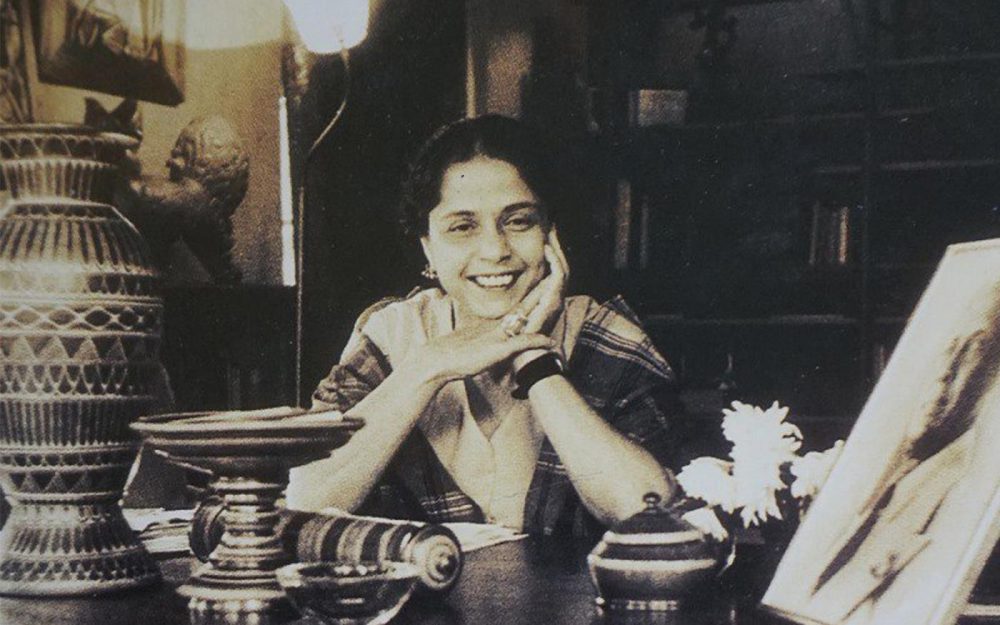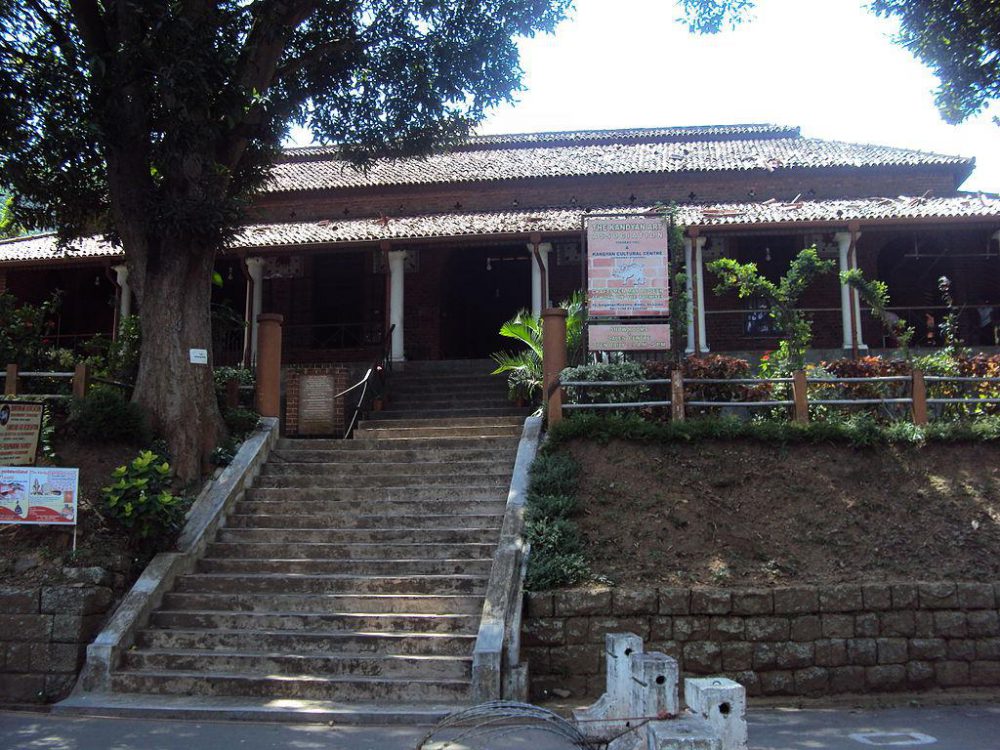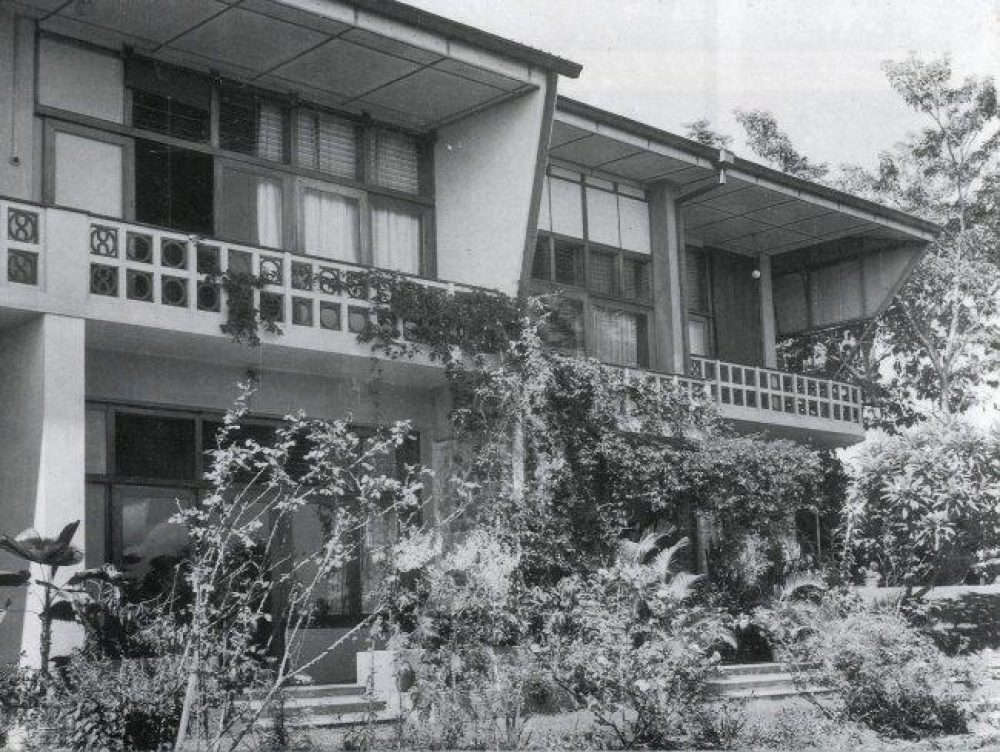“Asian Woman Architect”: Minnette de Silva’s Vision of Tropical Modernism
Emily Nonko looks back at the career of architect Minnette de Silva, whose designs paved the way for what is now known as Tropical Modernism.

Architect Minnette de Silva.
“Asian Woman Architect” is the label Minnette de Silva gave herself in a world in which there were none. This was the 1940s in Sri Lanka, and de Silva was on the cusp of forging a path for the architectural style now known as Tropical Modernism. Today, the term evokes stunning vacation homes that blend Modern architecture with nature. “It’s became a catch-all, an easy-to-use way of describing a glamorous style of architecture in exotic locations,” says Iain Jackson, a professor at the Liverpool School of Architecture. But what’s now known as an alluring, and expensive, aesthetic took root as a more humble, radical style in tropical areas previously dominated by British colonial architecture.
Sri Lanka was one such place after the country gained its independance from the British Empire in 1948. Geoffrey Bawa—considered by many to be Sri Lanka’s foremost architect—is often credited as one of the the founding fathers of Tropical Modernism. But according to writings by architect David Robson, Bawa was heavily influenced by de Silva’s designs and thinking. She was one of the first to engage with Sri Lanka’s independence, the effects of colonialism, and local culture and craftsmanship through architecture.
Not only that, her use of the term “regionalism” predates its use by international historians by a quarter of a century. “She was offering an alternative to the intellectual straightjacket of international modernism by demonstrating that a building could be modern and of its time while responding to context and tradition,” Robson writes. “But she was a woman in a provincial backwater and nobody was listening.” Indeed, architecture has historically been a career path off-limits to women, and the field remains limited in its diversity with regard to both gender and race to this day.
De Silva was born in 1918 in Kandy, one of the largest cities in Sri Lanka. Her parents influenced her desire to pursue architecture and the eventual goals of her practice: Her father, George E. de Silva, was a leading figure in the anti-colonial movement, and Agnes Nell, her mother, was a universal suffrage activist who campaigned for the preservation of traditional arts and crafts. Minnette de Silva was educated in England and returned to Sri Lanka in 1929. By the time she decided to pursue architecture—a decision “unprecedented for a woman of her background,” writes Robson—it was clear it wouldn’t happen in her home country. She was barred from training in Sri Lanka’s capital, Colombo, so persuaded her father to allow her to travel to what was then known as Bombay to study at a private architecture school.
De Silva’s career was critically shaped by the events of 1948. Sri Lanka gained independence from England, which had exercised rule over the island since 1815. De Silva became the first Asian woman to be elected a member of the Royal Institute of British Architects, and earned her first commission back in Kandy, designing a house on a hillside above the central Kandy Lake.
For the project, she used modern construction, like concrete columns, trussed rafters, and glass blocks. She also employed more traditional materials like rubble, brick, and timber, while incorporating local handicrafts, including lacquer work, Dumbara weaving, and terra cotta tiles, as well as the work of Sri Lankan artists. It was clear then that de Silva’s design practice would continue to engage with broader cultural and political questions surrounding the newly independent country. She wanted to draw on Sri Lanka’s traditional cultural, historical, and intellectual resources, without rejecting new technological influences from Western Europe and the United States. As early as 1950, she had coined the phrase “modern regional architecture of the tropics” as the name of what she was trying to do.

Architect Minnette de Silva’s Kandyan Art Association Centenary Cultural Centre in Sri Lanka, completed in 1984.
As the British established colonies across the world, they left behind a distinct colonial architecture that’s typically known for its formalism, based off strictly symmetrical designs without regard to native art traditions. In the West Indies, explains Iain Jackson, “[building engineers] viewed the tropics as a hostile, aggressive, unhygienic place, wrapped up in notions of racial prejudice and a dislike for the colonial conditions they were working in.” And the construction of bungalows, military barracks, and labor housing in the tropics by the British empire “was inextricably entangled with medical and racial discourses, biopolitics and the political economy of colonialism,” according to an article by architect Jiat-Hwee Chang and art historian Anthony D. King. De Silva’s career was part of a major shift to help move Sri Lanka toward an independent identity, distinct from colonialism—a change that resonated internationally.
Tropical Modernism—as a response to colonial architecture’s negation of local people, customs, and place—took hold not just in Sri Lanka but also across Africa, India, the Caribbean, and the Middle East. Modernism was an ideal style to build off of, according to Jackson, as it was purportedly more neutral. Tropical Modernism, he says, “picked upon modernism and its clean white lines, its supposed neutrality, and tried to modify that.”
To be sure, de Silva and her counterpart Geoffrey Bawa both studied in Europe and traveled the world, from Bombay to Paris and Hong Kong, through their practices, “so it’s hard to tell if their [styles] were directly against colonial architecture, or if they were part of the elite group also trying to deliver a modernizing architecture [to the rest of the world],” according to Jackson. De Silva had also formed a close relationship with Le Corbusier, and his work heavily influenced hers. “But there was still a rejection of the classic, imperial style,” Jackson says. “People like Minnette de Silva were looking for an architecture of that place, an authenticity or style that responded to the local conditions.”
De Silva wrote extensively on her attempts to create a design process that better reflected Sri Lankan culture. “In our tradition there has always been a strong, symbiotic relationship of architecture and environment,” she notes in an ambitious writing project she began in the 1960s, titled A Comparative History of South and South East Asian Architecture. Of the work, she says her aim was to to develop a study on “all forms of town and village planning, folk design, crafts, etc. with research into the influence of history, climate, geography, economics and culture on this architecture.” Though this writing was never completed, the architectural historian Tariq Jazeel, in his book Sacred Modernity: Nature, Environment and the Postcolonial Geographies of Sri Lankan Nationhood, viewed de Silva’s attitude as “a corrective to colonialism’s violent interruptions in the post-colony’s national identification and determination.”

Architect Minnette de Silva’s Coomaraswamy Twin House in Colombo, Sri Lanka, completed c. 1970–72.
As she continued to practice through the latter half of the 20th century, de Silva designed homes following the Modernist celebration of sun, light and air, allowing the abundance of nature to come into the house. In the mid 1980s, she took on the design of the Kandyan Art Association Centenary Cultural Centre. There, she landscaped the whole site similar to local Kandyan villages and used natural materials like stone, timber, and rocks. Local craftspeople, including women, were hired to build it; the result, a squat brick building with an airy, column-lined front porch, topped with a geometric timber roof.
The Life and Work of an Asian Woman Architect, which de Silva compiled herself, remains the most complete look at her influential career; it’s something of an autobiographical scrapbook, career résumé, architectural monograph, and amateur history of Sri Lanka. She never received international acclaim for her career, which architectural historian Anooradha Iyer Siddiqi calls “an erasure of Minnette de Silva’s work from a global canon of modern architecture… predicated in part on the demolition and neglect of Sri Lankan buildings within her vast yet little-known architectural portfolio, and her eclipse in the literature by narratives that foregrounded South Asian peers whose work may have been more easily consumed, through European, masculine, or chauvinist lenses.”
De Silva’s own house and studio was set in the wilderness on a high bluff of Kandy, always open to her friends and colleagues. Over the last few years of her life—she died penniless in 1998—it began to deteriorate as nature took over again. After a life balancing the natural landscape with the built environment, she let nature take hold, with trees pushing through the open trellises and monkeys and insects invading rooms filled with architectural drawings, artwork, and memorabilia.
Architectural Modernism, of course, would live on. The idea of site-specific, environmentally-sensitive design would also gain traction as concerns over humankind’s environmental impact increased. De Silva may not have been fully recognized for paving the way, but her work opened a space for something completely new, something free, in her home country, and it resonated around the world. It was, explains Jazeel, “what she considered democratic architecture, liberated from the historical and ornamental impediments of Colonial Westernization.”



